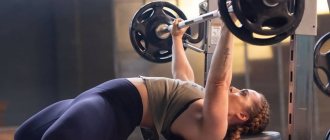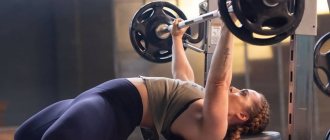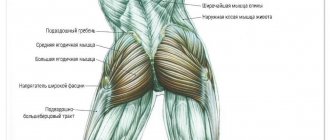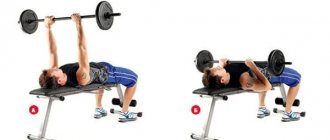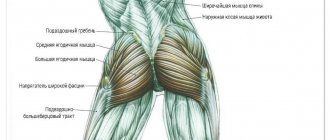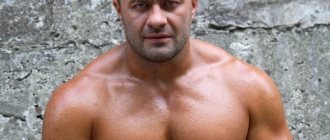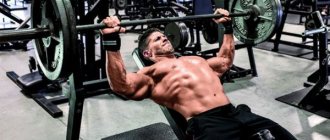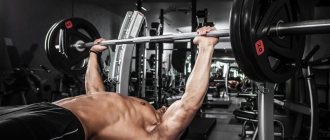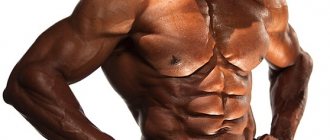The pectoral muscles are one of the largest and most complex muscle groups in the body. That is why, for proper chest training, it is important to use not only basic, but also isolating exercises that load the muscles from different angles.
In addition, to pump up the pectoral muscles, constant progress in working weights is necessary, since the chest responds well to hypertrophy - and this, in turn, requires perfect adherence to the exercise technique. How often should you pump your breasts?
Pectoral muscles - anatomy
The main muscles of the chest are the pectoralis major and minor (subscapularis) muscles. The pectoralis major muscle has a triangular shape, woven directly into the shoulder - this is how the muscles of the chest and shoulders are connected. The subscapularis muscle is located under the major muscle and plays a stabilizing role.
The pectoral muscle group also includes the serratus anterior muscle, which lies closer to the side of the body and to the shoulder. This muscle has nine characteristic “teeth” attached to the upper ribs. Since its main function is to abduct and approximate the shoulder blades, pumping requires adduction and dilation.
The best exercises for chest muscles
Exercises for the pectoral muscles can be performed with a barbell, dumbbells or on blocks. Dumbbells and blocks allow you to use stabilizer muscles in the exercise and specifically pump individual sections of the chest, while the barbell is the preferred choice when working with heavy weights, since its range of motion is reduced:
Pushups
Push-ups are a key anatomical exercise for the chest muscles. If you want to pump up your chest, you first need to learn how to do push-ups correctly so that you can feel the pectoral muscles in action. However, we note that push-ups have an extremely limited resource for breast growth, since they do not allow you to work with additional weight.
// How to learn to do push-ups?
Dips
One of the best exercises for a comprehensive workout of the upper body, and, in particular, the lower part of the pectoral muscles, the entire shoulder girdle and triceps. When going down, the movement should be slow and controlled, when going up, it should be powerful and jerky (as if you are pushing your body up).
// Dips - technique
Bench press
The bench press is a basic strength exercise for the pectoral muscles. When performing, it is important to monitor the technique - do not relax the muscles at the top and bottom points of the movement, do not straighten your elbows and never touch the barbell to your chest. Raise the barbell up, slowly counting 1-2, hold for 3-4 and lower it for a count of 5-6.
// Bench Chest Press - Step by Step Technique
Lying dumbbell flyes
A key exercise for working the serratus anterior muscle and giving the chest the correct “square” shape. Use dumbbells that are not too heavy, focusing primarily on the feeling of the muscle stretching. At the bottom of the movement, do not drop your elbows too low or spread your arms too wide.
// Lying dumbbell flyes - biomechanics of exercise
Incline Dumbbell Press
Exercise to work the upper part of the pectoral muscles. When performing the exercise, do not lift your feet off the floor and make sure that the core muscles (especially the abs) are in constant slight tension - when lifting the dumbbells, you should feel how this tension helps push the weight up.
Features of chest exercises with dumbbells
You need to approach training a massive muscle group wisely. Dumbbells are a complete replacement for the classic barbell press, as well as numerous exercise machines. However, there are a number of features that need to be taken into account during the training process.
The information will be useful not only for beginner athletes, but also for experienced athletes:
- Chest exercises with dumbbells require technique. Don't chase the scales. Use projectiles of acceptable weight to set the trajectory of movements and learn to maintain balance. Stabilizers need long-term training!
- Due to the massiveness of the chest muscles, it is necessary to alternate types of exercises. Adjusting the angle of the bench will help pump up the upper, middle and lower bundles.
- After training your chest, give yourself time to recover. Eat well, get enough sleep. Until the muscles have recovered, there is no point in loading them again.
- Don't forget about your back and legs. Spend time on all the muscles in your body to avoid slouching and visual imbalances.
- Alternate use of the projectiles gives better concentration to work on each side.
- The chest is most often trained together with the biceps, so we recommend that you look at: Top 12 biceps exercises for the gym and at home.
Regarding weight. The optimal working weight is one that you can do for 10-12 repetitions. Start with small dumbbells and gradually move up. Choosing the optimal projectile is not difficult. The main thing is to take your time.
To perform chest exercises with dumbbells, you will need a bench with a variable incline. In the gym, as a rule, there are special sports benches, but at home you can use a fitball.
Chest muscle development program
Since the chest is a fairly large muscle, its mass is increased through strength training for hypertrophy with a constant increase in working weight. In addition, negative repetition techniques (when you are helped to lift the barbell, but you lower it yourself), as well as techniques for achieving failure and pumping exercises are effective for the growth of chest muscles.
In a simplified form, an exercise program for developing chest muscles may look like this:
- Dips - 2 sets and max. number of repetitions.
- Bench press – 4 sets of 10 reps.
- Incline Dumbbell Press – 4 sets of 10 reps.
- Lying dumbbell raises - 4 sets of 12 reps.
Working out the shape of the muscles
The shape of the pectoral muscles largely depends on genetics, however, the inclination of the body during exercises and the width of the arms affect exactly how the muscles develop. For example, the most massive outer part of the chest is best worked with horizontal bench presses, performed either with a barbell or with dumbbells or on blocks.
The upper part of the chest is included in the work in exercises such as dumbbell or barbell bench press with an incline (both 45 and 30 degrees), the lower part - with push-ups on uneven bars or a barbell press with a reverse inclination (head down). The center of the pectoral muscles - with the help of all kinds of extensions on blocks and machines, as well as when bench pressing a barbell with a narrow grip.
Why is there no result?
If you are pumping your chest intensely, but the muscles stubbornly do not grow and the chest does not acquire the desired shape, most likely you are making one of three typical mistakes - either chasing excessively large working weights to the detriment of technique, or training the same bundles of the pectoral muscle, or pump your chest too often, not giving your muscles a chance to recover.
Remember that the latissimus dorsi, deltoid, and pectoralis major and minor muscles are a single fascia woven together by connective tissue. To increase muscle elasticity, as well as to speed up recovery time, myofascial massage is recommended.
***
Training the pectoral muscles is one of the keys to creating a sporty and athletic body, since these are the muscles that form a strong and massive body. The main rules for successful breast pumping are constant progress of working weights, a variety of exercises, ideal execution technique, as well as sufficient time for rest and recovery.
Implementation recommendations
- Beginners can perform isolation exercises, but no more than 2 exercises, and then only in the first stages of muscle adaptation and strengthening of ligaments. Later, you need to move on to basic techniques that fully develop muscle volume.
- When an athlete has mastered the bench press technique and achieved results in strength and mass, he can use isolation techniques to fully develop the chest and work on “weak” areas.
- There should be fewer isolation exercises in the complex, and they should only complement the basic ones, and not be the basis of the training. Thus, in a separate chest workout there should be at least three basic exercises, then only two isolating exercises will be enough. If split training involves exercises for synergists, in this case triceps, then two basic chest exercises and one isolating exercise will be sufficient. But for the triceps, only two exercises after working the pecs are enough.
And also read: Chest exercises with dumbbells → 5 exercises to make your chest wider → How to pump up your chest on the parallel bars →
Breast care while breastfeeding
During lactation, it is necessary to pay special attention to the condition of the breast. Firstly, violation of hygiene rules can lead to cracked nipples or mastitis, which will negatively affect breastfeeding, which means the baby may be left without the milk he needs. Secondly, proper breast care during breastfeeding avoids many problems,
- Hygiene. During lactation, the breasts should be washed with clean warm water 1-2 times a day. You should not shower after each feeding, as frequent washing can cause dry skin. Lanolin creams can be used to prevent cracked nipples. They do not require rinsing and are safe for the baby.
- Support and protection. Supportive breastfeeding bras can help prevent breast sagging. Special inserts in the bra will absorb remaining milk and protect the nipples from dryness and inflammation.
- Hardening and massage. Contrast showers and air baths will improve blood supply to the breasts, which, on the one hand, will increase the flow of milk, and on the other, will increase muscle and skin tone. Breast massage after childbirth will be an effective prevention of mastitis and will also have a positive effect on the condition of the skin. You need to knead your breasts after childbirth with careful circular movements from the periphery to the center.
- Proper nutrition. After childbirth, a woman especially needs a complete, balanced diet, since during the feeding period all the beneficial substances primarily go to the baby. A lack of vitamins and microelements leads to a deterioration in the condition of the skin, including the breasts, so after childbirth it is imperative to take vitamin and mineral complexes. Pregnoton Mama is a source of the most important micronutrients for the body. Biotin, omega-3 polyunsaturated fatty acids, vitamins D and E will improve skin condition, and iron will restore tone to the chest muscles.
Why does the inner part of the breast lag behind?
First of all, this potential is genetically based; from birth, some have a well-developed back, others have powerful legs, others have voluminous arms, but at the same time the chest does not lend itself to the necessary development.
The second reason is an incorrectly designed training program. For example, many people like to perform barbell bench presses and sometimes dips, while forgetting about the incline bench, fly-ups, crossover work, and so on. Which ultimately develops a certain area of the pectoral muscles, which over time becomes overdeveloped and differs in volume from other muscle areas.
Find out the full list of chest exercises here.
Each muscle group - 1 time per week
At the other extreme is the idea that each muscle group should only be trained once a week. As a rule, here one or two muscle groups are loaded during the entire workout, but with a very large volume (15-20 approaches) for each. The next training session for the same group will take place no earlier than in a week.
"Behind"
If this is how most bodybuilders train, then perhaps this is the most effective option? After all, they are some of the most muscular people on the planet.
There is no doubt that this approach works at the elite level of bodybuilding. But there are usually two reasons why this happens: hormonal support (steroids) and genetics, which combine together to produce excellent results that mere mortals cannot achieve.
For many, training each muscle group once a week is more about maintaining results rather than improving them.
"Against"
Very few “naturals” (i.e., not taking anabolic hormones) are able to grow by training this way. Most will not progress due to lost supercompensation .
The theory of supercompensation says that after intense training, various body systems and energy reserves are depleted. Some time after training, the body recovers, all indicators rise to the previous, pre-training level and a little more beyond it, so that the next training session is easier to endure.
If a person reloads their muscles during the supercompensation phase, they improve their performance and progress. If you don’t get into this phase, skip it, then the body returns to the pre-training level, and the person marks time from training to training.
This often happens if you train a muscle group once a week. If you do not take steroids, then usually the results from such training are obtained by people whose supercompensation phase is slow.
Another disadvantage: there is a risk of overdoing the training volume in one session. There is an optimal volume for each muscle group, so either too little or too much can be a problem preventing you from achieving results.
Doing a million overlapping exercises is generally pointless for most trainees. One of the reasons why many people do not have good results is that they always leave the gym feeling that they have completely “killed” the target muscle group. They focus on fatigue rather than progress. But the exercises should complement each other, and not copy.

